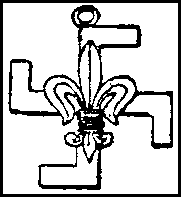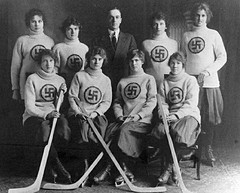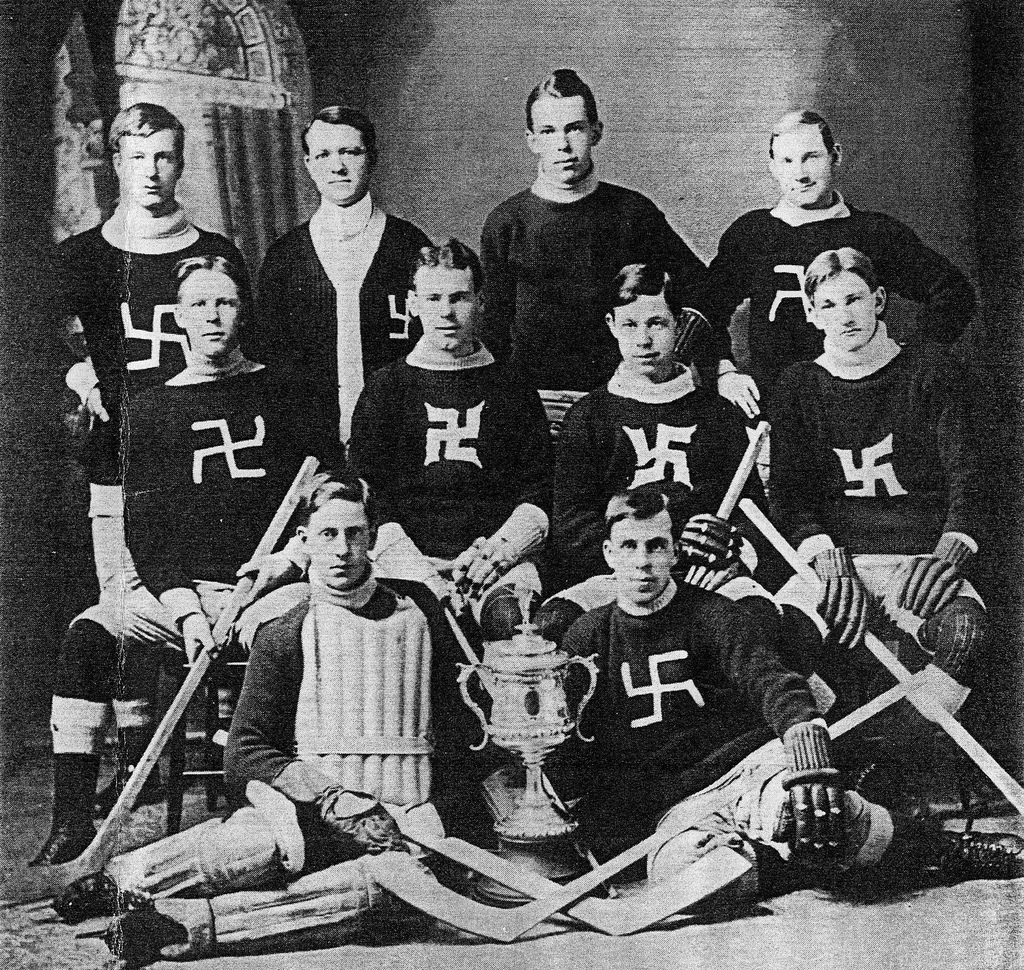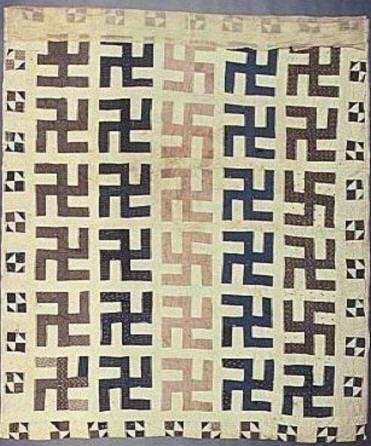Flashback Friday.
I found this 1917 advertisement for swastika jewelry while browsing through the NY Public Library Digital Gallery. The text reads in part:
To the wearer of swastika will come from the four winds of heaven good luck, long life and prosperity. The swastika is the oldest cross, and the oldest symbol in the world. Of unknown origin, in frequent use in the prehistoric items, it historically first appeared on coins as early as the year 315 B.C.
As this suggests, while the symbol of the swastika is most frequently associated with Hitler and Nazis during World War II, and is still used by neo-Nazi groups, the symbol itself has a much longer history. From wikipedia:
Archaeological evidence of swastika-shaped ornaments dates from the Neolithic period. An ancient symbol, it occurs mainly in the cultures that are in modern day India and the surrounding area, sometimes as a geometrical motif and sometimes as a religious symbol. It was long widely used in major world religions such as Hinduism, Buddhism and Jainism.
Before it was co-opted by the Nazis, the swastika decorated all kinds of things. Uni Watch has tons of examples. Here it is on a Finnish military plane:
A Boy Scout badge:
A women’s hockey team called the Swastikas from Edmonton (from 1916):
Another hockey team:
In the comments, Felicity pointed to this example:
She writes:
My mom is a quilter and collects antique quilts (when she can afford them). She says that while in general, antique quilts and quilt-tops have gone up a great deal in price over the decades, there’s still one sort you can pick up for a song — swastika quilts.
It’s kind of sad to think of somebody in 1900 putting all that time and hand-stitching into a ‘good luck’ quilt that is now reviled.
All of these examples occurred before the Nazis adopted the swastika as their symbol (and changed it slightly by tilting it on a 45-degree angle). Of course, the original meaning or usage of the swastika is beside the point now. Because it is so strongly associated with the Nazis, it’s impossible to use it now without people reading it as a Nazi symbol. And in fact it’s unimaginable that a group in the U.S. or Europe would use the swastika today without intentionally meaning to draw on the Nazi association and the ideas espoused by Hitler and his party.
Wendy Christensen is an Assistant Professor at William Paterson University whose specialty includes the intersection of gender, war, and the media. You can follow her on Twitter.







Comments 94
Elizabeth — June 3, 2008
To an educated eye one can automatically tell those are not the Nazi swastikas, as the Nazi swastika is on a slant.
Wendy — June 3, 2008
True, the Nazi swastika is tilted on a 45 degree angle. Nonetheless, the swastikas in this 1917 ad evoke Nazism now, post-WWII (which I imagine is why it was part of the online library gallery of racist images and symbols). My guess would be that either version of the image would evoke Nazism if someone wore it on t-shirt today.
ESS — June 4, 2008
This post reminded me of one done by Paul Lukas at UniWatch, a website that examines the "Obsessive Study of Athletics Aesthetics," that examined the use of the swastika as a logo for various sports teams.
Here is the link: http://www.uniwatchblog.com/2007/11/01/and-look-theres-a-young-marge-schott-in-the-front-row/
Sociological Images » WHAT WE’VE BEEN UP TO BEHIND YOUR BACK (DECEMBER 2008) — January 1, 2009
[...] Remember how the swastika didn’t used to connote total evil? Neither did we. We added several more examples of pre-Nazi uses of the swastika to this post. [...]
Felicity — January 2, 2009
My mom is a quilter and collects antique quilts (when she can afford them.) She says that while in general, antique quilts and quilt-tops have gone up a great deal in price over the decades, there's still one sort you can pick up for a song -- swastika quilts.
It's kind of sad to think of somebody in 1900 putting all that time and hand-stitching into a 'good luck' quilt that is now reviled. Here's one photo I found: Nevada state museum
stompie smax — January 2, 2009
incidentally, that use by world religions isn't entirely past tense. it probably comes as a bit of a shock to many visiting westerners that the swastika is used as the symbol for buddhist temples on most japanese maps.
carrie — January 2, 2009
To add to the comment about temples in Japan, in Korea we have swastikas marking traditional medicine shops and other small Buddhist run/related shops.
Sociological Images » WHAT WE’VE BEEN UP TO BEHIND YOUR BACK (JANUARY 2009) — February 1, 2009
[...] found another instance of pre-nazi uses of the swastika, this time the symbol was used in a warm, cozy quilt. Thanks to Felicity who pointed us to it [...]
T — February 3, 2009
The tiles in the entrance of a pre-war (1928) apartment building in Brooklyn feature swastikas. I used to live there and the porter told us that a lot of the buildings in the neighborhood had swastika motifs -- I have seen swastikas worked into the borders of wood floors as well. According to the porter, a lot of these buildings were constructed by teams of native american builders from upstate New York. He also claimed that building inspectors had tried to get them to replace the tiles over the years.
simono — February 3, 2009
At least in germany, austria everybody knows of pre-nazi swastika use. though we call it "swastika" in non-nazi context ("hakenkreuz" - if its nazi context).
simono — February 3, 2009
oh and you are not allowed to wear those in public, at least in germany+austria. that could theoretically get you in jail for a long time (short version: http://en.wikipedia.org/wiki/Verbotsgesetz_1947)
Lila — February 26, 2009
There are big swastika tiles on the landings of the stairs in one of the buildings at the University of Chicago. I have no idea how old they are, but it really freaked me out last week when I noticed I was standing on one! :)
Ego Kornus — March 28, 2009
Great post,
and Swastika is good!
Sociological Images » What We’ve Been Up To Behind Your Back (June 2009) — July 1, 2009
[...] Gwen and I saw a swastika design built into a brick chimney. It reminded us of Wendy’s fascinating post on the history of the swastika symbol from June 2008. Before WWII, it didn’t signify oppressive racist ideology at all. The [...]
seatangle — July 4, 2009
hitler was so unoriginal.
World War II Era Converse with Swastika Soles » Sociological Images — June 2, 2010
[...] also our post on the surprising history of the symbol. var object = SHARETHIS.addEntry({ title:'World War II Era Converse with Swastika Soles', url: [...]
Allie — June 2, 2010
http://swastika-info.com/en/startpage/usa/1069618500.html
Sara — June 7, 2010
We Hindus and Jains can't use our symbol in the USA because people think its a Nazi symbol. http://en.wikipedia.org/wiki/Jainism & http://en.wikipedia.org/wiki/Hindusim
Most awkward gift wedding gift ever | When Latke Met Ladki — September 19, 2011
[...] opening). In Hinduism and many other Indian religions like Jainism and Buddhism, it is regarded as one of the oldest symbols of prosperity, good luck, health and heaven dating as far back as 3300–1300 BCE. The swastika is as common and accepted in Hindu communities [...]
Mike T. — August 5, 2013
Didn't swastika symbolize the sun before hitler has used it? I remember seeing on tv that in India there are still bridges that had swastika decorations.
orse — November 11, 2013
kjdfkmlf;ll
Ely — May 23, 2014
The guna people here in Panama have used the swastika since forever. It's on their flag:
http://upload.wikimedia.org/wikipedia/commons/thumb/f/fc/Flag_of_Kuna_Yala.svg/750px-Flag_of_Kuna_Yala.svg.png
That's Guna Yala's flag (the autonomous territory, the "comarca" where a good deal of the gunas live).
I guess it helps that Panama is a country that has never had much to do with the nazis. Sure, when I think about swastikas, my brain screams "nazis", but if I see it around here, in Panama, I'm like "ohhhhh, a guna thing, that's a really pretty handicraft!!!".
Not to mention all the hindus who wear swastika necklaces and stuff sometimes.
Daniel Pose — May 24, 2014
If the 1917 swastikas are remarkable, then readers will marvel at photos showing that in 1917 the US's Pledge of Allegiance used the early stiff-armed salute that was adopted later in Germany. The pledge was the origin of the Nazi salute and Nazi behavior (see the discoveries of the historian Dr. Rex Curry).
The German National Socialist's symbol was not a "swastika" in that the German socialists did not call their symbol a "swastika." They called their symbol a "Hakenkreuz," which means "hooked cross" because their symbol was a type of cross. It was also not a swastika in that they used it to represent crossed "S" letters for their dogma -"socialism"- as alphabetical symbolism (again see work of Dr. Curry). German turned their symbol 45 degress and points it in the "S" letter direction. So, the Germans did not "hijack" the symbol. The hijacking of the symbol was done by people who did not want to disparage the Christian cross, so they began deliberately mis-identifying the German socialist symbol as a "swastika." That continues to this day. If you want to rehabilitate the swastika, then you should explain these differences so that others will understand.
One reason that the writer Christensen does not know this is because she uses wakipedia (wikipedia). She should not let students her university cite wakipedia and neither should she. The swastika is one example of many topics on which wakipedia will never publish the truth.
The Swastika Before World War II | NYC Startup News — May 25, 2014
[…] Via: The Swastika Before World War II […]
Sahil Choudhry — May 25, 2014
It's still very commonly used in Hindu religion.
illuminaupolis — May 25, 2014
She neglected that the swastika was a sacred symbol in native American culture. The 45th Infantry in Oklahoma had to redesign their insignia when WW2 started.
Dan — May 25, 2014
The KiMo theatre in Albuquerque has a beautiful swastika motif. Apparently swastikas were widely used by the Navajo and other tribes.
La esvástica antes de la Segunda Guerra Mundial (ENG) — May 25, 2014
[…] La esvástica antes de la Segunda Guerra Mundial (ENG) […]
nyrablog — May 25, 2014
I was given a card for an Indian holiday and it had a sparkly swastika. took me a few seconds to register it was religious as it was facing opposite and on on 90º, but still was a laugh when my uncle I rarely see gave it to me.
Greg — May 25, 2014
Wendy..you have a Phd and you cited wikipedia. are you for real?
The Swastika before World War II — May 26, 2014
[…] BY : http://thesocietypages.org/socimages/2014/05/23/symbolism-the-swastika/?utm_source=feedburner&a… […]
Profesor_frink — May 26, 2014
The symbol was also used in the roman culture as a symbol of protection and good luck (much like in the hindu culture).
Here you can see the floor of a roman domus in moroco where the swastika can be easily seen:
http://elimperiodedes.files.wordpress.com/2014/03/the-swastika-volubilis-morocco-5.jpg
And here another example on roman baths at Sant boi de Llobregat, Spain, near Barcelona:
http://3.bp.blogspot.com/-4lp7sk-mINQ/UPw9rKjjgPI/AAAAAAAAAVM/p13Qw5xbfqQ/s1600/P1010513.JPG
Marc Girbau — May 26, 2014
I don't want to see in 50 years a nazi symbol, just a nice greek pattern. symbol http://laborallatn.files.wordpress.com/2012/04/greca.jpg
La esvástica antes de la Segunda Guerra Mundial (ENG) | El batiburrillo de ideas de sexitante — May 29, 2014
[…] noticia original […]
La esvástica antes de la Segunda Guerra Mundial (ENG) | España en el mundo — May 31, 2014
[…] noticia original […]
parmenio — June 7, 2014
Noted magazine editor Edward Bok, in his autobiography _The Americanization of Edward Bok_, wrote a chapter on building his 'dream house' in Merion, Pa., called 'Swastika', with that motif carved into the stonework. Lived in that neighborhood a few years back, thought of finding if the building still exists, taking some photos...
IMHO — June 24, 2014
I was so thrilled to see your jewelry reference. I recently purchased a Victorian bangle bracelet with a Swastika and knew from the moment that I saw it and the USA manufacturer information, that is was the real deal, Victorian.
Lee — August 17, 2014
I love the swastika. It's a very ancient symbol of my people, the white European race, also known as the Aryans or Indo-Europeans. Long live our sacred symbols and our sacred blood! We created civilization and we will defend it against all subhumans.
Lee — August 17, 2014
P.S. In Latvian, which developed from our sacred language, the word for hello is "Sveiki" or "Sveiks" and the national Anthem is Dievs Sveti Latvia. Sveiki, Sveiks, Svastika. All hail the sacred blood. Death to subhumans!
Lee — August 17, 2014
P.P.S. my last post for tonight. Please indulge me. I just want to say the following. Follow the swastika. And DEATH TO ALL ENEMIES OF OUR SACRED ARYAN BLOOD.
sshawxs980 — December 4, 2014
umm.... cool!
Bob McDuff — January 14, 2017
Wendy Christensen is an idiot! The German National Socialists never used the Swastika!
Bob McDuff — January 14, 2017
Inside the Austrian church Hitler grew up in. This is a HAKENKREUZ. And ancient GERMAN symbol representing the Sun. In Northern Europe this represented crops, travel, marriage, sex, happiness, and all things associated with warm weather and Summer. Hitler did not "steal" anyone's "Swastika".
https://uploads.disquscdn.com/images/d1cc872cc4909f80655ac3307a81a3627a8e28a869f5921dc518fac8c23101d4.jpg
Bob McDuff — January 14, 2017
Ancient Germanic HAKENKREUZ on a Runestone.
NOT INDIAN!
https://uploads.disquscdn.com/images/2ab860ade25a81b6dabb80ac3e3b56e385deb6c180a711483d12b2dad7dc2eac.jpg
? Fashy Cassy — October 27, 2017
Time to revamp and bring back the swastika!
Joshua Baxter — May 10, 2018
The problem is that people are too ignorant and lazy to do a little research for themselves and break their indoctrination. It's sad that one of the world's oldest symbols that was used throughout the globe, is now almost permanately associated with Nazism, at least with those who care not to educate themselves. Of course in today's climate anyone in America who would dare to wear it would be knocked over the head with a bike lock or sprayed in the face with pepper spray, all while an angry mob of people scream "Nazi" at you. It a little hard to explain The difference between a swastika and a hakenkrutz while you are running from an angry mob.
G. Fent — July 4, 2018
Indeed, it is hard to explain the difference while running from an angry mob. I recently just found a swastika quilt! I trashpicked it and it's in mostly excellent condition, just a few small repairs needed. I was told it came from a local church charity....not surprising in a small midwestern town. The patchwork fabric prints make it a wonderful addition to my antique quilt collection and match the beautiful pink glass shade with a swastika border and flowers that cam out of an old building in Chicago. Being raised as a jew, it's nice to see these domestic things of beauty made with care and attention to detail, making them so obviously not a symbol of hate.
S.JAGAN — August 31, 2018
SWSTIKA SYMBOL belongs to INDIA or BHARAT, in Dwapara Youga, means 10000 years back, SRIKRISHNA uses the symbol as flag, to fought against traitors, got win
against kowravas, threre are some mantras missing beneth the symbol..
please refer the "BHAGAWATA GEETA", and find truth about the symbol
Jonathan — September 13, 2018
I appreciate everything all of you have said. I live in Minnesota, am an odinist and wear a swaztika inside a black sun symbol on my elbow. I have only had one person say anything to me about it calling it a symbol of hate. I tried my best to explain the true meaning behind it but this girl only cared about what she believed it stands for. People are very ignorant when it comes to symbology. That's my belief anyways. It seems that people get uncomfortable having these conversations and revert to their defensive uneducated understanding. I am fighting to take this powerful symbol back as a symbol of peace, prosperity, auspiciousness and luck. I wish the media would show stories of the truth, but I know that's not what sells. And it's not what the public wants to acknowledge.
alan — September 21, 2018
history of the fylfot ( swastika ) , in north west Europe, the Germanic nations and Britain, goes back 2000 years
Craig Murray, PhD — January 1, 2019
Interesting summary. I have become interested in how the swastika was used in scouting and have a web page sharing what I have learned:
http://www.worldscoutingmuseum.org/swastikas.shtml
Greg — January 10, 2019
I was looking through old old family picture from around1900 to 1917 and on some of the pictures are in folding covers that have the Swastikas embossed on and in the covers ,photos from Cass City Michigan this article helps with explanation and the symbols are not on 45 degree angle and make sense to stand for good luck ,long life , prosperity
Anonymous — January 17, 2019
yas
Jonah Barton — January 17, 2019
Idk why they even had a war oh wait i know why u have to contact me to find out
Jonah Barton — January 17, 2019
jb034919@sdale.org
Tara Mandarino — February 10, 2019
It is sad that our society only relates back to all the negative within this symbol, however our society could relate a lot to all the negative within itself through different events that happened throughout the years.
Robert the Duck — February 21, 2019
I will agree that this symbol should not be used in the weetern world because it is mostly associated with the Nazis. However, you can’t ban one symbol of evil and leave others alone. There are shirts with the hammer and sickle or Che Guevara that are worn by stupid kids in high school or college. That needs to be nipped in the bud. Wearing a Che Guevara t-shirt is worse than weating a shirt with Ted Bundy or John Gacey on it.
Magdalena — June 13, 2019
The Swastika has also been found in Macedonia, in many locations, including in an old church Plaosnik, in the old town Ohrid. It is said to symbolise rebirth if facing left (as in mother giving birth to daughter who then gives birth) and it symbolises unity and strength when facing right (as in we are stronger when in unity). The two swastikas, i.e. left and right come together to form a cross, which was a symbol used much earlier than Christianity.
Connie — September 22, 2020
it was interesting to find out the swastika was used before the Nazi adopted it. I had no idea it was used long before that and had other historical meanings. I was shocked to learn about the women's and men's hockey teams as well.
| Cheddarback Block of the Month – Month 1Sentimental Stitches — December 11, 2020
[…] hope you'll take the time to read this well written and educational blog post. and this article from The Society Pages too. I have the highest regard for the Jewish people […]
Peter Linton — February 20, 2021
The symbol is visible in a couple of 20s era family pictures of a beach property. It really begs the question of "what was the intent of the decoration?" Granted, (more than once, I grant) that this was before Nazi Germany. Yet the symbol was one used by German Nationalists stemming back to the 1800s--Hitler did not just stumble upon it. My family also has German roots. Was there a connection? I doubt there was an intentional connection--there is no record of my family being connected to any political movement. But does this also reflect a certain willful ignorance, meaning did they just not wish to know, or strive to know of the Fascist Nationalism taking over in Europe, in Italy especially? It was privilege not to know. Can the comparison to Swastikas in 20s American culture be compare to, say, the use of Black face? Both were accepted, or should I say ignored by those who were not affected. Where do we draw the line between polite decorum and political dehumanization?
Joanne G — April 10, 2022
My dad was a wonderful Christian man born in 1898, I inherited a picture of him at age 18 taken in 1916. Pictures of that time were not good even if taken in a studio. He had a pin on his suit collar and I could not see what it was so I used my jewel magnifying glass to see it and to my shock it was a swastika. I did research to find out that the Nazis did not use this sign until 1920. The swastika was used by Christians and by many others and goes back to BC but never attached to evil. Hitler changed all of that. What a shame. I was relieved.
305 WRONGFULLY ACCUSED: THE SWASTIKA IS NOT HITLER’S HAKENKREUZ | SKRBH — December 22, 2022
[…] symbol was on Boy Scouts paraphernalia, Coca Cola products, on the uniform of hockey teams, in fashion accessories, […]
Nancy Beasanski — October 9, 2023
I actually inherited the cross pictured in the upper left-hand corner of that ad, the large one with the beautiful engraved embellishment. I do not know what to do with it, my grandmother-in-law would have been the one living in the right era to have worn this for the right reasons. Not the reasons associated with it so sadly today. I don't know what to do with it and no one in the family wants any of these things of hers.
Shelly Brewer — June 16, 2025
Ea aperiam alias voluptas molestiae inventore repellendus Deleniti sed dolor quia eaque voluptate omnis voluptate maxime sit quidem repudiandae recusandae info_7,